Adding to a stream of judicial decisions that directly affect community colleges and their students, U.S. Supreme Court last week declined to lift an injunction against implementing the Biden administration’s Saving on a Valuable Education (SAVE) income-driven repayment (IDR) plan. So, for now, borrowers enrolled in this plan must wait for the courts to settle things.

The SAVE plan is the broadest of the loan repayment changes initiated by the Biden administration after the Supreme Court’s June 2023 ruling that Biden’s sweeping loan forgiveness proposal, which provided up to $20,000 of debt relief (for students who were awarded Pell Grants; $10,000 for others), was unconstitutional. However, the legal basis for the SAVE plan differs from the one used for the earlier loan cancellation initiative — it derives from the Higher Education Act’s original provisions on loan repayment, rather than the Higher Education Relief Opportunities for Students (HEROES) Act, which had a much narrower focus.
SAVE details
The SAVE plan would:
- Lower monthly payments to 5% from the current 10%.
- Raise the amount of income sheltered from any repayment.
- Ensure that balances do not grow when interest does not need to be repaid.
- Shorten the timeline to forgiveness for borrowers with original balances of $12,000 or less.
This last feature is of particular benefit to community college borrowers, given the relatively low amounts that they borrow when they do take out federal loans. (Only about 12% of all community college students borrow, and that percentage has been declining.)
In any case, the borrower-friendly benefits were projected to cost tens of billions of dollars, and the SAVE plan was met with opposition from Republicans in Congress and a legal challenge from Missouri and six other states under Republican control.
Where things stand
While the injunction remains in effect, The U.S. Education Department (ED) is unable to provide loan forgiveness under SAVE, must continue charging accrued interest, and cannot implement changes to income protection or repayment amounts under the plan.
Furthermore, while borrowers can still fill out an application to enroll in SAVE, whether and when those applications will be processed is unclear. The eight million borrowers who had already enrolled in the program will continue to be in interest-free forbearance as litigation continues. These will not owe payments and are not at risk of default, but they will not be able to earn credits towards forgiveness under IDR or the Public Service Loan Forgiveness program.
Looking ahead
The unpredictability and confusion caused by judicial interventions in administrative actions are only likely to increase in the coming months. The Supreme Court’s ruling at the end of last session overturning the Chevron doctrine that gave deference to federal agencies in their promulgation of regulations will likely encourage even more suits challenging executive actions. And now, they will also stand greater chances of success. Although efforts to overturn Chevron have largely come from the political right, the ruling will surely elicit a variety of suits from the left side of the political spectrum as well.
The ongoing challenges to SAVE, as well as any future challenges to the executive branch’s authority around student loans, present a complicated environment for loan counseling. The American Association of Community Colleges will continue to monitor the student loan repayment landscape and its implications for students and institutions.





